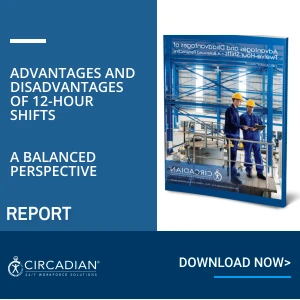The 12-hour shift schedule is one of the most hotly debated topics in industries that operate around the clock. Managers, shift workers, union representatives, regulators, and experts continually debate the pros and cons of 12-hour shifts compared to the traditional 8-hour workday. While many believe the 12-hour shift model offers a range of benefits, there are also several myths surrounding this type of schedule. Let's dive into seven common myths about the 12-hour shift and uncover the facts.
Myth #1: Switching to a 12-Hour Shift Work Schedule Reduces Staffing Needs
Fact: Shifting to a 12-hour shift work schedule does not reduce the number of workers required to staff your operation. The total number of hours your facility operates remains the same, and employees will still work those hours—albeit with fluctuating weekly totals. In some cases, 12-hour shifts may actually require more staff due to absenteeism or the need for overtime coverage. With 8-hour shifts, it's easier to extend work hours by asking employees to come in early or stay late, but that's not as feasible with a 12-hour shift due to safety and labour law concerns.
Myth #2: Any 12-Hour Shift is Better Than the Best 8-Hour Shift
Fact: While 12-hour shifts may provide more days off and seem attractive, they are not a one-size-fits-all solution. Some 12-hour shift schedules can be physically and socially disruptive. Managers who push a 12-hour shift work schedule without gaining employee buy-in may face resistance and a host of unexpected workforce challenges. It's essential to communicate with employees and evaluate whether the 12-hour shift fits the unique needs of the organization and workforce before implementation.
Myth #3: There Are More Practical 8-Hour Shift Options Than 12-Hour Shifts
Fact: Despite the common use of 8-hour shifts, there are actually far more practical 12-hour shift options available. In fact, there are over 300 different 12-hour shift schedules compared to around 40 core 8-hour shift patterns. This flexibility allows organizations to tailor 12-hour shifts to better suit their operational needs. While the number of options is greater, it doesn't automatically mean 12-hour shifts are better—it simply provides more possibilities to explore.
Myth #4: Workers Will Earn Less on a 12-Hour Shift Work Schedule
Fact: Workers typically see a slight wage increase—about 2%—when transitioning to a 12-hour shift work schedule. This boost in pay comes from working 52 hours during some weeks (40 hours regular time and 8 hours overtime) and 36 hours during others. However, if cost neutrality is part of the plan, wages can be adjusted to eliminate this pay increase. It's important to consult state laws and union agreements to ensure that any shift changes comply with local regulations regarding overtime and pay.
Myth #5: Performance Decreases on a 12-Hour Shift
Fact: Contrary to popular belief, performance on 12-hour shifts can actually improve with proper planning and a biocompatible schedule. Performance is closely linked to alertness, which is influenced by the time of day, the quality of sleep, and the number of hours awake. Workers who manage their sleep schedules effectively can maintain, or even enhance, performance on 12-hour shifts. Additionally, fewer shift changes in a 12-hour schedule reduce the risk of errors that often occur during shift handovers.
Myth #6: Anyone Can Get Used to a 12-Hour Shift with Enough Effor
Fact: While many workers can adjust to a 12-hour shift work schedule, some may find it challenging—especially older workers or those in physically demanding jobs. Fatigue is a common issue, particularly when working multiple consecutive shifts. Single parents or workers with caregiving responsibilities might also struggle to find suitable childcare arrangements for the long hours required by 12-hour shifts. Flexibility in break schedules can help ease the transition, but the fact remains that not everyone is suited for such long workdays.
Myth #7: Managers Prefer 12-Hour Shifts
Fact: While 12-hour shifts are gaining popularity in 24/7 operations, not all managers favor them. Transitioning to a 12-hour shift work schedule requires careful planning, especially when it comes to pay structure and ensuring cost neutrality. Additionally, communication between managers and workers can become more difficult on 12-hour shifts, as the schedules often limit face-to-face interaction. Managers may need to schedule meetings at inconvenient times to accommodate 12-hour shift workers, creating additional challenges.
Conclusion: Understanding the Reality of 12-Hour Shifts
The 12-hour shift work schedule offers a range of benefits, including more days off and fewer shift handovers, but it also comes with its own set of challenges. By debunking these common myths, managers and workers can better understand the potential pitfalls and advantages of 12-hour shifts.
As with any scheduling model, the key to success lies in thoughtful implementation, clear communication, and the flexibility to adapt to the unique needs of both the operation and the workforce.











